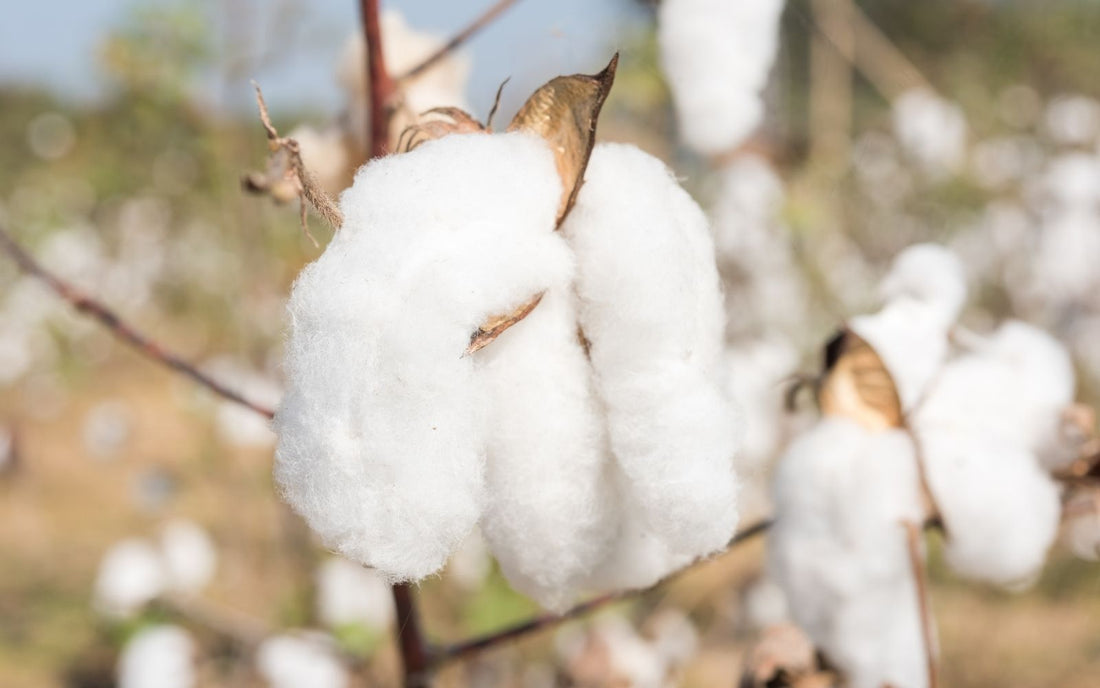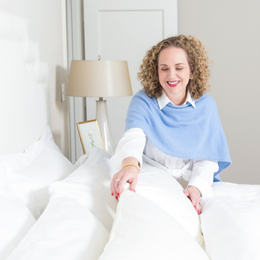We live our lives in cotton. From the clothes we wear, the sheets we sleep on, to the swabs we use to clean ourselves or our homes, cotton is all around us. Yet, you may not have heard of how it is weighed and measured, how it is selected, or how and where it is grown and manufactured into all the different items that we use on a daily basis.
What is staple length?
An important factor in the measuring and selecting cotton is the staple length. So, what exactly is staple length? Not to be confused with thread count or weave, staple length measures the density of the fibers.
When you picture cotton, you probably picture the soft, fluffy, little cotton ball on top of a brown stem. That little fluff is called the “boll.” The staple refers to the length of the fibers that make up the boll. Staples are considered short, long, or extra-long. Shorter boll fibers are referred to as “short-staple,” and the longer boll fibers are referred to as “long-staple” or “extra-long-staple.” The longer the fibers, the softer and more durable the cotton.
Long-staple vs. short-staple cotton
Short-staple cottons are still important and still get used. They are most appropriate for everyday products such as clothing, namely denim, personal care products such as cotton pads and swabs, and feminine hygiene products. Longer staples of cotton are used for sheets, towels, blankets, and more luxurious fabrics.

What are the types of cotton?
There are four main types of cotton: Upland cotton, Pima cotton, Levant cotton, and tree cotton.
Levant cotton is primarily grown in Africa and the Middle East. It is used to make fabrics, and the other parts of the plant are used medicinally for many cultures in those regions. Tree cotton, or Indian cotton, is mainly grown in India and Pakistan and is primarily used for muslin. Muslin fabric is breathable and holds its form well; it is used in clothing, cooking, and the medical industry as gauze for wound care.
Upland cotton makes up 95% of the global market and is grown worldwide. It is primarily used for clothing and personal care. Although it is great for clothing fabrics, it is not always the best for bedding as it weakens. Pima cotton can be either a long or extra-long-staple cotton and is native to South America but commonly grown in the southwestern United States under the brand name “Supima.” This is the most luxurious type, used worldwide in luxury capacities. It resists pilling and fading well and is soft and supple. Egyptian cotton is also extra-long-staple cotton in the same family as Pima cotton but only grown in the Nile Valley of Egypt.
Why is this important?
You can’t always look at a label and know the full story. A label can say 100% cotton, but it doesn’t attest to the cotton quality. Understanding the differences between short-staple and long-staple cotton can help you be an informed consumer. It can help you know cost and value and help you spend your money wisely.
For example, perhaps it is better for you to splurge on the best bedding instead of on t-shirts. You have likely already learned that a standard t-shirt, usually made with short-staple cotton, is good enough for daily wear and you may grow bored of it after a year or so. You also have likely learned that the t-shirt will begin to wear and tear over a relatively short period of time. The right set of sheets should last for years and provide you with a quality tactile experience and sleep. Quality sheets are harder to come by. Unlike a t-shirt, good sheets are not staring at you from the aisles of every department store. Knowing that sheets made with Supima cotton are going to be quality and grown in America can help you spend your hard-earned dollars wisely.
What else should you look out for?
Brands that produce lower-quality bedding may churn out labels that look deceptively well-made. As a smart consumer, you should pass on bedding labeled as “100% cotton,” as it is likely made of Upland cotton. There is nothing wrong with Upland cotton, but for the best investment, go for Pima. Touch the fabrics before you buy. If they are made of lower-quality cotton or mixed with a combination of high and low, they won’t have the same hand feel. Sheets or blankets made out of mixed or substandard cotton may have rough patches or not feel as smooth.
Some manufacturers try to fool consumers by costuming an inexpensive or inferior cotton fabric with a weave that may make it feel softer, or they will use more threads per square inch to make the sheets have a higher thread count. Although with all the extras, it may be hard to determine just by touch or feel that short-staple or lower quality cotton fabrics will not stand up to frequent washes, constant and rough wear, and they will begin to pill, fade or lose structural integrity. Higher thread counts do not always make better sheets. You should be wary of super-high thread counts as they could be masking the truth. Long-staple cotton does not need over-the-top thread counts to make them soft. They are.
Why Thomas Lee?
Thomas Lee Sheets only uses American-grown Supima cotton with a sturdy percale weave. Therefore you can trust that you are getting softness and strength, and longevity. Not only are the sheets crisp and classic, but Thomas Lee Sheets holds itself to the highest ethical and environmental standards. Thomas Lee’s percale sheets have been earning five-star ratings and reviews from publications across the country, such as Popsugar Living, The Chicago Tribune, and more, and a coveted award from The Sleep Foundation. Join them in trying these sheets you can feel great about buying.




